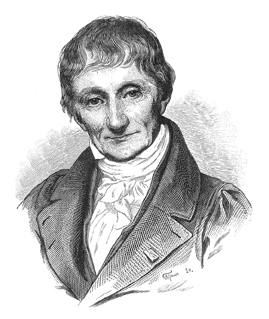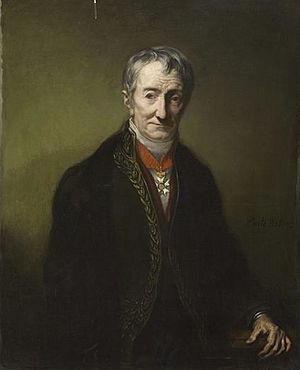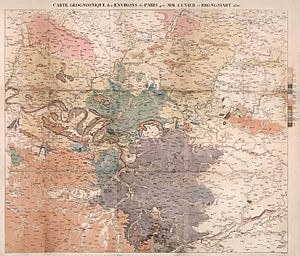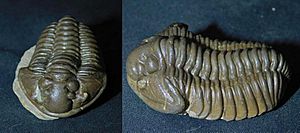Alexandre Brongniart facts for kids
Quick facts for kids
Alexandre Brongniart
|
|
|---|---|

Alexandre Brongniart
|
|
| Born | 5 February 1770 |
| Died | 7 October 1847 (aged 77) Paris, France
|
| Nationality | French |
| Scientific career | |
| Fields | |
| Institutions | Sèvres - Cité de la céramique Manufacture nationale de Sèvres Royal Swedish Academy of Sciences |
Alexandre Brongniart (February 5, 1770 – October 7, 1847) was a French scientist. He was a chemist, a mineralogist (someone who studies minerals), a geologist, a paleontologist (someone who studies fossils), and a zoologist (someone who studies animals).
He worked with Georges Cuvier to study the geology of the area around Paris. Brongniart was the first to classify certain rock layers. He also helped make geology a real science by collecting facts and information in the 1800s.
Brongniart also started the National Museum of Ceramics in Sèvres, France. He was the director of the Sèvres Porcelain Factory from 1800 until he died in 1847.
Contents
Life and Work
Alexandre Brongniart was born in Paris, France. His father, Alexandre-Théodore Brongniart, was a famous architect. Alexandre's son, Adolphe-Théodore Brongniart, became a well-known botanist (someone who studies plants).
In 1797, Brongniart started teaching natural history. This is the study of nature, including animals, plants, and rocks. In 1822, he became a professor of mineralogy at the Museum of Natural History in Paris.
In 1800, he was chosen to lead the Sèvres porcelain factory. He stayed in this important role for 47 years. He used his science knowledge, especially in chemistry, to improve how ceramics were made. He also had good management skills and understood art.
Brongniart created a new way to classify reptiles. He also wrote several books about mineralogy and how to make ceramics. He studied trilobites, which are ancient sea creatures. He also made important discoveries in stratigraphy. This is the study of rock layers. He used fossils to help figure out the age of these layers.
In 1819, he became a member of the American Philosophical Society. In 1823, he joined the Royal Swedish Academy of Sciences.
Studying Reptiles
When he was younger, Brongniart focused on studying reptiles. In 1800, he published a book called Essai d'une classification naturelle des reptiles. In this book, he compared the bodies of different reptiles to put them into groups.
He created four main groups:
- Chelonia (turtles)
- Sauria (lizards)
- Ophidia (snakes)
- Batrachia (amphibians like frogs and salamanders)
Brongniart noticed that Batrachia were quite different from the other reptile groups. Later, in 1804, another scientist named Pierre André Latreille moved Batrachia into their own group called Amphibians. Today, amphibians are not considered reptiles.
Mapping Paris Geology
One of Brongniart's most important works was a book published in 1811. It was called Essai sur la géographie minéralogique des environs de Paris. He wrote it with Georges Cuvier. They studied the geology around Paris.
At that time, Cuvier was trying to figure out the age of fossils. He wanted to rebuild ancient mammals based on the time periods they lived in. Their book described nine different rock layers that had formed over a very long time.
Brongniart found that some rock layers had fossils of sea animals, like mollusks. Other layers had fossils of freshwater animals. By seeing these layers switch between sea and freshwater, he helped show that the Earth's layers were not just formed by a shrinking ocean.
Brongniart and Cuvier were among the first scientists to study the Earth by looking at its fossils. They didn't just rely on what the rocks looked like. Their work also helped disprove a theory called Neptunism, which said all rocks formed in water. Their findings led Cuvier to develop the idea of catastrophism. This idea suggests that Earth's history has been shaped by sudden, powerful events.
Using Fossils to Date Rocks
Another big step Brongniart made in stratigraphy was using fossils to identify rock layers in different places. Before, people often tried to match layers by their depth or type of rock. But Brongniart showed that fossils were a better way to tell if layers were the same age, even if the rocks looked different.
In 1822, Brongniart published the first detailed study of trilobites. He classified many types from Europe and North America. He also tried to group them by their age. This work was very helpful for later studies of ancient rock layers.
Family
Alexandre Brongniart married Cecile Coquebert de Montbret. She was the daughter of the French consul to England. They had three children. Their son, Adolphe-Théodore Brongniart, became a very important person in the study of ancient plants (paleobotany). Their daughter Hermine married Jean Baptiste Dumas, a famous chemist. Their other daughter Mathilde married Jean Victoir Audouin, a well-known naturalist.
See also
 In Spanish: Alexandre Brongniart para niños
In Spanish: Alexandre Brongniart para niños




